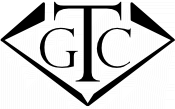My approach to clarity is focused on helping clients understand what they might see when viewing a given stone in person. I’m not proposing a new, gemologically useful clarity grading scale, nor am I giving a statement about the quality of the stone. Rather, I’m trying to communicate the visual impact of the stone’s inclusions — because, in the end, it’s all about how the stone looks to you.
| LC10 | Loupe Clean 10x. |
| LC3 | Loupe Clean 3x. |
| EC1 | Eye Clean, close inspection. |
| EC2 | Eye Clean, arm’s length. |
| Inc1 | Visible, minor inclusions. |
| Inc2 | Visible, significant inclusions. |
N.B.: My formal studio photographs are taken through a 105mm macro lens. The lens allows for close, sharp images because it significantly magnifies the gemstone for the camera. But the same magnification exaggerates small inclusions; keep in mind, details visible in a magnified image may be completely invisible to your eye.
Loupe Clean 10x (LC10)
In the jewelry trade, the 10x loupe is the universally accepted standard for judging a gemstone’s clarity. My LC10 grade indicates a stone that is clean under quick examination at 10x.
Yes, you read correctly: a quick examination. My idea here is a brief inspection of the stone for inclusions that impact how the stone looks to a client. The inspection is not intended to be a thorough study as a collector or gemologist might perform. From a purely practical perspective, if you can’t see an inclusion quickly under magnification, it is not an inclusion that will change how the stone looks.
Loupe Clean 3x (LC3)
The LC3 grade indicates a stone that is clean under quick inspection at 3x magnification. It can also be understood as something like “obvious inclusions using 10x”.
Why 3x magnification? It is a matter of convenience, really. Many professional gem cutters, myself included, use a visor as a magnification aid while cutting stones for the jewelry trade. The magnification of visors varies, but I like 3x.
Another way to think about LC3 is as a loose midpoint between an eye clean stone and one that is clean under 10x. Like the LC10 grade, LC3 is primarily concerned with how evident inclusions are. So, this grade could also be stated as “clean with your strong reading glasses on, but you’d see inclusions with a 10x loupe”.
Eye Clean, close inspection (EC1)
“Eye clean” is probably the most used clarity description for colored stones. Unfortunately, everyone who uses it probably has a different idea of what it means. For me, eye clean means the average consumer can’t see any inclusions in the stone without magnification.
“Average consumer” means just that: someone who enjoys gemstones, but isn’t a gemologist, jeweler or collector. Anyone practiced at looking carefully at gemstones may see an EC1 level inclusion generally missed by everyone else.
“Close inspection” means that you are viewing the stone in-hand at about 9 inches from the eye. Or, put another way, with the stone as close to your eye as you can comfortably focus on it.
Eye Clean, arm’s length. (EC2)
EC2 assumes you’re looking at the stone without magnification. However, in this case the stone is resting in your hand at approximately arm’s length from your eye. Arm’s length is how someone standing close to you will likely see the stone if mounted in a ring.
EC2 stones will have visible inclusions when viewed closely, but they can’t be too obvious or eye-catching.
Visible, minor inclusions. (Inc1)
Inc1 stones have visible, non-distracting inclusions visible at arm’s length.
For this clarity grade, the phrase “non distracting” is key. A non-distracting inclusion is one that you can comfortably ignore because it doesn’t really impact the overall look of the stone.
Visible inclusions. (Inc2)
Inc2 stones are easily visible. But here it is important to remember: this is an objective description of the stone. Many fine gems have easily visible inclusions by their nature — and some easily visible inclusions are actually sought after.
For example, classic demantoid garnet from the Ural Mountains in Russia is prized both for its color and its famous “horse-tail inclusions.” A demantoid garnet that has a well-centered, eye-visible horse-tail would receive an Inc2 grade on my clarity scale. But it would also receive a significant premium in pricing because of its rarity and market demand.
Another example is Oregon sunstone. Often, sunstone contains clouds of copper platelets called schiller. When properly oriented, schiller can be a visible and positive feature to a fine sunstone.
